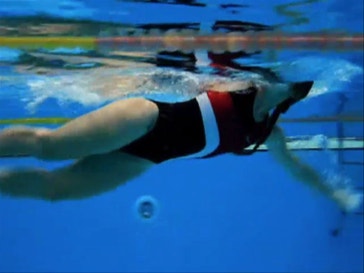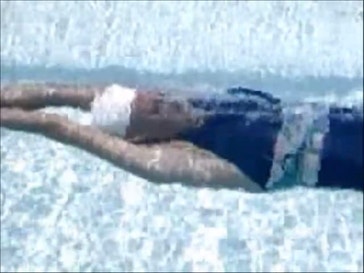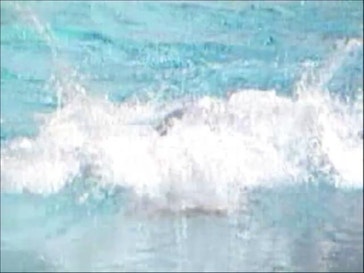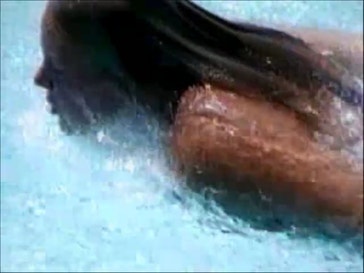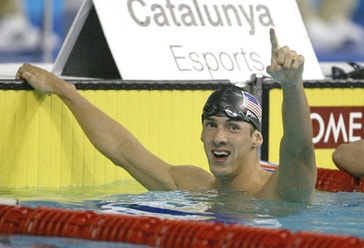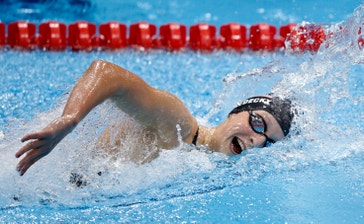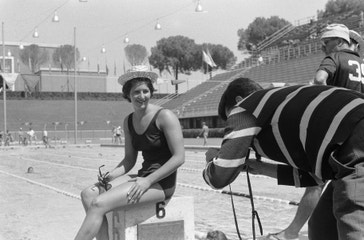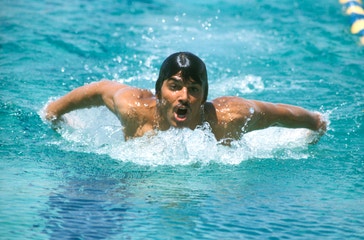오늘의 한마디
Swimming
Ian Thorpe
Swimming is the act of moving through water by using the arms and legs. Swimming is a popular form of recreation, an important international sport, and a healthful exercise.
People of all ages—from the very young to the elderly—swim for fun. Throughout the world, millions of people enjoy swimming in lakes, oceans, and rivers. Others swim in indoor or outdoor pools. Many schools, recreation centers, motels, apartment buildings, and private clubs have an indoor or outdoor pool. Thousands of communities provide pools for residents. Many families even have a pool in their backyard.
During the 1900's, swimming became a major competitive sport. Today, thousands of swimmers compete in meets held by schools, colleges, and swimming clubs. The best international swimmers take part in annual meets in many parts of the world. Swimming races have always been a highlight of the Summer Olympic Games. Many long-distance swimmers attempt such feats as swimming across the English Channel or from the southern California coast to Santa Catalina Island.
Good swimmers can also enjoy various other water sports. Such sports include springboard and platform diving, surfing, water skiing, board sailing, water polo, scuba diving, and synchronized swimming. The ability to swim well makes such sports as fishing and boating safer and more fun. Above all, the ability to swim may save a person's life in an emergency in the water.
Swimming is one of the best exercises for keeping physically fit. Swimming improves heart action, aids blood circulation, and helps develop firm muscles.
Water safety
Swimming, boating, fishing, and other water sports are among the most popular forms of recreation. Yet many people lack knowledge of water safety rules or take dangerous chances. Every year, about 3,600 people drown in the United States, and about 250 people drown in Canada. Most of these drownings would not occur if everyone knew how to swim and observed basic water safety rules. The following discussion deals with basic rules and techniques that could save your life or help you save another person's life.
First of all, know how to swim. Many schools and community recreation departments provide swimming lessons. Lessons are also frequently offered by organizations such as the Young Men's Christian Association (YMCA) and the American Red Cross.
Never swim alone. Always swim with a companion and know where that person is at all times. Swim only in areas protected by lifeguards. A swimming area should be free of obstacles and the water should be clean and clear. It is dangerous to swim in an unprotected ocean, river, or lake.
Water used for diving must be deep and be clear enough to see the bottom. Look for swimmers before you dive. Plan your dive and, following your entry into the water, avoid hitting the bottom by steering up with your hands out in front.
Whether you are a beginning or experienced swimmer, a knowledge of survival bobbing can help you survive an accident or other difficulty in the water. Survival bobbing, also known as drownproofing, enables you to float a long time on your front while using little energy. You fill your lungs with air and relax your body. Your arms and legs hang down limply, and your chin flops down to the chest. The air in your lungs holds your back above the water's surface. When you need a breath, you quickly exhale through the nose, lift your face out of the water, and inhale through your mouth. You then return to the restful floating position. You can raise your mouth higher out of the water for a breath by pressing your hands down or squeezing your legs gently together.
Only a trained lifeguard should attempt a swimming rescue. But even if you are a nonswimmer, you can help a swimmer who is in trouble. If the person is nearby, you can extend a board, pole, shirt, towel, or similar object and pull the swimmer to safety. But be sure to lie down or keep your body low to avoid being pulled into the water. If the swimmer is too far away to reach an object, you can throw a life preserver, a board, or any other object that will float and support the swimmer.
Swimming kicks and strokes
Swimmers move their legs, feet, arms, and hands in certain ways to propel themselves through the water easily and quickly. The movements of the legs and feet are called kicks. These movements combined with movements of the arms and hands are called strokes.
The basic kicks. Swimmers use four types of kicks: (1) the flutter kick, (2) the breaststroke kick, (3) the dolphin kick, and (4) the scissors kick. Each of these kicks is used in doing one or more of the strokes described later in this section.
The flutter kick is the most popular kick and the easiest for swimmers to learn. The power to do the kick should come from the upper leg. The legs are alternately moved up and down with a slightly relaxed bend at the knees. The propulsion comes from the feet as if kicking mud off the toes.
The breaststroke kick begins with your legs fully extended and the toes pointed to the rear. By bending your knees, you bring your heels toward your hips just under the surface of the water. As your feet near the hips, turn your ankles so the toes point outward. Then, without pause, push your feet outward and backward, squeezing your legs together until the toes again point to the rear.
The dolphin kick resembles the flutter kick. But in the dolphin kick, you move both of your legs up and down at the same time and keep more bend in your knees.
The scissors kick begins with your body turned to either side. Your legs are together and the toes pointed back. Draw your knees up and then spread your legs wide apart like the open blades of a scissors, moving your top leg forward from the hip. Then snap both legs together to their original position.
The basic strokes are (1) the front crawl, (2) the backstroke, (3) the breaststroke, (4) the butterfly, and (5) the sidestroke.
The front crawl is the fastest and most popular stroke. You move your arms in a steady, circular motion in combination with the flutter kick. One hand reaches forward above the water while the other pulls beneath the water. You breathe by turning your head to one side just as the hand on that side passes your leg. You inhale through the mouth. You exhale through the mouth or nose while keeping your face in the water.
Front crawl
The backstroke, or back crawl, is performed as you lie on your back. It is a restful stroke because your face is always out of the water and breathing is easy. As in the front crawl, each arm alternately moves in a steady, circular motion in and out of the water while your legs do the flutter kick.
Backstroke
The breaststroke is another restful stroke. It is done in combination with the breaststroke kick. You begin with your face in the water, arms and legs fully extended, and the palms facing outward. You then sweep out your arms as your hands push downward and outward. The hands continue to circle and come together under the chin. As the hands begin to push down, you lift your head for a breath. Finally, you again extend your arms and legs and glide forward. You then repeat the sequence. You make a breaststroke kick at the end of the stroke as your arms extend for the glide.
Breaststroke
The butterfly is a difficult stroke to learn, but it is smooth and graceful if performed correctly. In this stroke, you swing both arms forward above the water and then pull them down and back to your legs. As your arms start to move toward your legs, you lift your head forward and take a breath. Then you dip your head into the water and exhale as your arms move forward again. You make two dolphin kicks during each complete stroke, one as your hands enter the water and the other as your arms pass under your body.
The sidestroke is done on your side, whichever side is more comfortable. Your head rests on your lower arm, which is extended ahead with the palm turned downward. The top arm is at your side. The palm of the lower hand presses down in the water until it is beneath the shoulder. At the same time, the top hand slides up to meet the lower hand. The legs do a scissors kick while the lower arm returns to an extended position and the palm of the upper hand pushes toward the feet. You then glide forward before repeating the sequence.
Other strokes. Swimmers use a number of other strokes besides the basic five. The most important include the dog paddle and the elementary backstroke. To perform the dog paddle, cup your hands and rotate them in a circular motion underwater, with one hand forward when the other one is back. You do a flutter kick with the dog paddle. Your head remains out of the water throughout the stroke. The elementary backstroke, like the regular backstroke, is performed on your back. You bring your hands up along the sides of your body to your shoulders. Next you turn out the hands and stretch the fingers outward. Then you push your hands down and glide. Swimmers do the breaststroke kick with this stroke.
Butterfly
Swimming as a sport
The Fédération Internationale de Natation (FINA) governs international swimming and other water sports at the amateur level. FINA consists of national associations from about 190 countries. These associations include United States Aquatic Sports, the Aquatic Federation of Canada, Swimming Australia, and British Swimming.
The pool. Swim meets are held in both long-course pools, which measure 50 meters (164 feet) long, and short-course pools, most of which measure 25 meters (82 feet) long. A 25-yard (22.9-meter) short-course pool is used almost exclusively in the United States but is not recognized in international competition. Long-course pools are divided into 6, 8, or 10 lanes, each of which is 2.5 meters (8.2 feet) wide. Short-course pools have 6 or 8 lanes. Each lane measures 2.1 or 2.4 meters (7 or 8 feet) wide. In U.S. championship meets, 8 lanes must be used in both long- and short-course pools. FINA recognizes world records set only in long-course pools or 25-meter short-course pools.
Water in a regulation pool must be at least 4 feet (1.2 meters) deep and have a temperature of about 74 °F (24 °C). Floats called lane lines run the length of the pool. They mark lane boundaries and help keep the surface of the water calm.
Regulation swimming pool
Kinds of races. Swimmers participate in five kinds of races—freestyle, breaststroke, backstroke, butterfly, and individual medley. In a freestyle race, a swimmer may choose any stroke. But swimmers always use the front crawl because it is the fastest stroke. In the individual medley, athletes swim an equal distance of each of four strokes. In order, the strokes are the (1) butterfly, (2) backstroke, (3) breaststroke, and (4) front crawl.
In national and international meets, individual freestyle races are held at distances of 100, 200, 400, 800, and 1,500 meters. Breaststroke, backstroke, and butterfly events are 100 and 200 meters long. The individual medley covers 200 and 400 meters. Open water races—held in rivers, lakes, or oceans—cover 25 kilometers (15.5 miles) in international competition and 5, 10, or 15 kilometers (3.1, 6.2, or 9.3 miles) in national races.
Team relays are among the most exciting swimming races. A team consists of four swimmers, each of whom swims an equal distance. Men's and women's teams participate in a 400-meter freestyle relay, a 400-meter medley relay, and an 800-meter freestyle relay. In the medley relay, each member of the team swims a different stroke for 100 meters in the following order: (1) backstroke, (2) breaststroke, (3) butterfly, and (4) front crawl. The FINA website at http://www.fina.org offers an up-to-date list of world records in the various kinds of swimming races.
American swimmer Jenny Thompson
Swim meets are held at various levels of competition, from local to international. So many swimmers participate in competitive swimming that qualifying times are established for large meets. To qualify for an event, a swimmer must at least equal the qualifying time for that race.
Large meets have several officials. The chief official is the referee. The referee supervises the other officials and makes sure that the swimmers follow regulations.
Each swimmer in a race is assigned a lane. The swimmers with the fastest qualifying times get the center lanes, and the slowest swimmers receive the outside lanes. The race begins at the sound of the starter's gun or horn. During the race, lane judges watch each swimmer's strokes and the turns at the end of the pool. An illegal stroke or turn disqualifies a swimmer.
In many meets, an electronic timing and judging system determines the order of finish and each swimmer's time to 1/100 of a second. The system begins automatically at the starter's signal. It records the time for each swimmer as the swimmer's hand touches a plate attached to the end of the pool.
Starts and turns. A swimmer's performance in a race partly depends on the skill used in starting the race and in turning at the end of each lap. At the start of a freestyle, breaststroke, or butterfly race, a swimmer gains time by diving as far as possible through the air before hitting the water. In these races, swimmers dive off a raised starting platform. In backstroke events, they begin in the water with their back to the lane. They hold onto a starting block attached to the end of the pool. At the starting signal, with their back slightly arched, the swimmers use both feet to push off from the pool's end as forcibly as possible.
Fast turns also save a swimmer time. Freestyle and backstroke swimmers use the flip, or somersault, turn. In this turn, they make an underwater somersault to reverse their direction after touching the end of the pool. Breaststroke and butterfly swimmers use an open turn, in which they keep their head above the water while reversing their direction.
Training. Most young people interested in competitive swimming begin by racing against swimmers in their own age group. In the United States, USA Swimming has established an age-group program for young swimmers. This program divides swimmers into four groups: (1) age 10 and under; (2) ages 11 and 12; (3) ages 13 and 14; and (4) ages 15 to 18.
Most swimmers in age-group programs work out once or twice a day for five or six days each week. Their training includes land and water exercises to increase endurance, speed, and strength. They also practice kicks and strokes.
Synchronized swimming is a water sport that combines grace, rhythm, and acrobatic skills. In this sport, swimmers perform certain movements to music that they have selected. They synchronize (match) these movements with the rhythm and the mood of the music.
Synchronized swimming was once called water ballet. It began as a form of exhibition swimming at water shows and remains a popular feature of such shows. In 1952, the first international rules were established for synchronized swimming as a sport. It became an Olympic sport in 1984.
International competition is divided into solo, duet, and team events. A team may have four to eight members. Each solo, duet, or team event has three sections: (1) figures, (2) technical routines, and (3) free routines. Figures are acrobatic movements. Technical routines must include required figures as directed by FINA. Free routines may consist of any listed figures, strokes, or parts of figures or strokes.
Almost 200 figures may be used in international competition. They are divided into four categories. The meet organizers draw lots to select one figure from each category that swimmers must perform.
The dolphin is an example of a commonly performed figure. It is also used in many routines. Swimmers begin the dolphin by floating on their back. They then pull themselves under the water head first, make a complete circle, and return to the floating position. In the dolphin bent knee figure, swimmers bend one knee while they perform the circular movement underwater.
A panel of judges awards points for each figure and routine. After each figure, the judges grade swimmers according to the difficulty of the figure and how well they performed it. The judges give each routine two scores, one for technical merit and one for artistic impression. Technical merit scores rate the difficulty and execution of strokes and patterns and the synchronization of swimmers with the music and with each other. Artistic impression scores include choreography, musical interpretation, and total presentation.
In water shows and swimming exhibitions, swimmers often base their synchronized routines on a story or a theme. For example, a team might act out a tale, such as Alice in Wonderland, with the aid of a narrator. The Cirque du Soleil water show called “O” has become internationally popular. It features synchronized swimming as well as high diving, acrobatics, and circus acts.
Michael Phelps
U.S. swimmer Katie Ledecky
History
Ancient peoples may have learned to swim by imitating the way some animals moved through water. Swimming became a popular form of exercise and recreation in many ancient lands. Its popularity declined during the Middle Ages, from about the A.D. 400's through the 1400's. Many people feared swimming because they thought plague and certain other diseases were spread by water. Swimming regained popularity in the early 1800's.
Organized swim meets became common during the mid-1800's. At that time, many swimmers used the breaststroke. A faster stroke, the Australian crawl, was developed in the late 1800's. Johnny Weissmuller, an American swimmer who later played Tarzan in motion pictures, changed this stroke slightly in the early 1900's. His version, now called the front crawl, is the fastest, most widely used stroke.
Men's international swim meets began in 1896 in the first modern Olympic Games. Women's meets were added in the 1912 Olympics. That year, Fanny Durack, an Australian, became the first woman to win an Olympic gold medal in swimming. Weissmuller won a total of five gold medals in the 1924 and 1928 Olympic Games. During his career, he set 67 world records. Dawn Fraser and Murray Rose, two Australian swimmers, starred in the Olympics of the 1950's and 1960's. In 1972, Mark Spitz of the United States won seven gold medals, more than any other athlete had ever won in a single Olympics. Janet Evans of the United States was the dominant woman freestyle swimmer of the 1980's and early 1990's. Kieren Perkins of Australia set several world records in freestyle swimming in the 1990's.
American swimmer Jenny Thompson, who competed in four Olympic Games in the 1990's and early 2000's, won eight gold medals, more gold medals than any other female American athlete in Olympic Games history. In the early 2000's, Australian swimmer Ian Thorpe won five gold medals and set many world records. American swimmer Katie Ledecky has set several world records in her career and won four gold medals and one silver medal at the 2016 Summer Olympic Games.
American swimmer Michael Phelps has been the most dominant swimmer of the 2000's. Phelps competed in the 2004, 2008, 2012, and 2016 Summer Olympics. At those four Olympics, he set Olympic Games records by winning 23 gold medals and 28 total medals. At the 2008 Summer Olympic Games, Phelps became the first athlete ever to win eight gold medals at a single Olympics.
Champion Australian swimmer Dawn Fraser
American swimmer Mark Spitz
Contributor
- Samuel James Freas, Ed.D., former President, International Swimming Hall of Fame.

